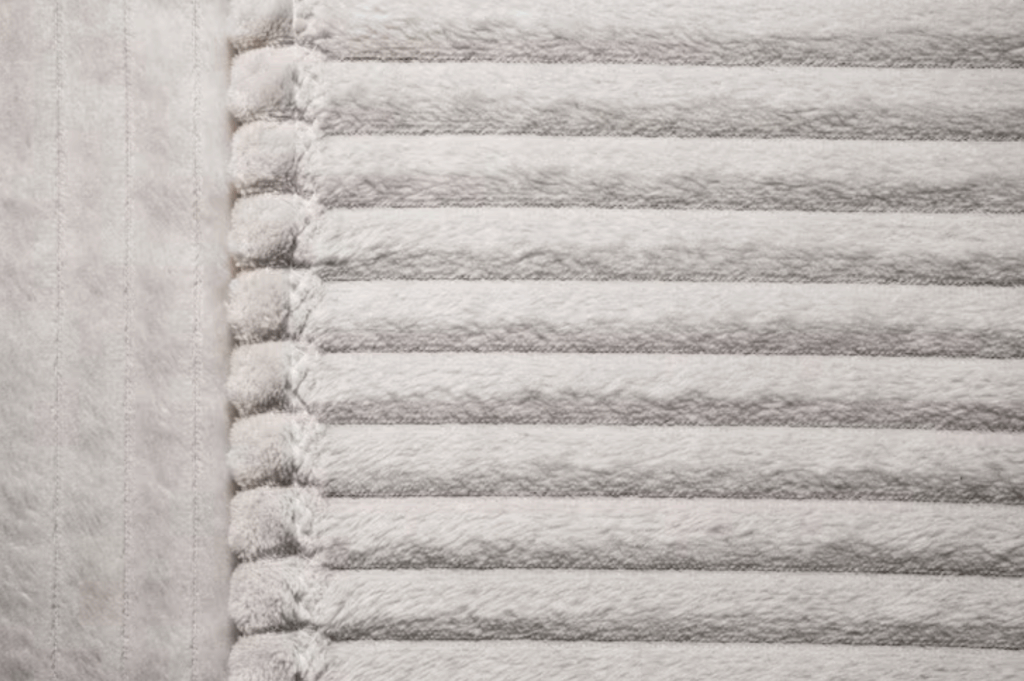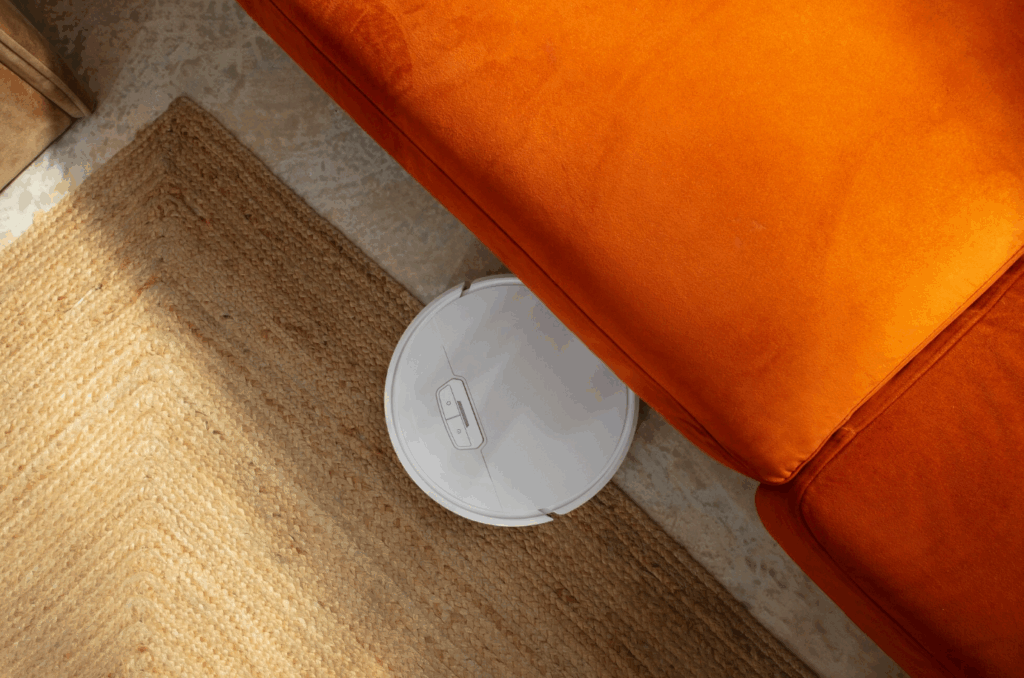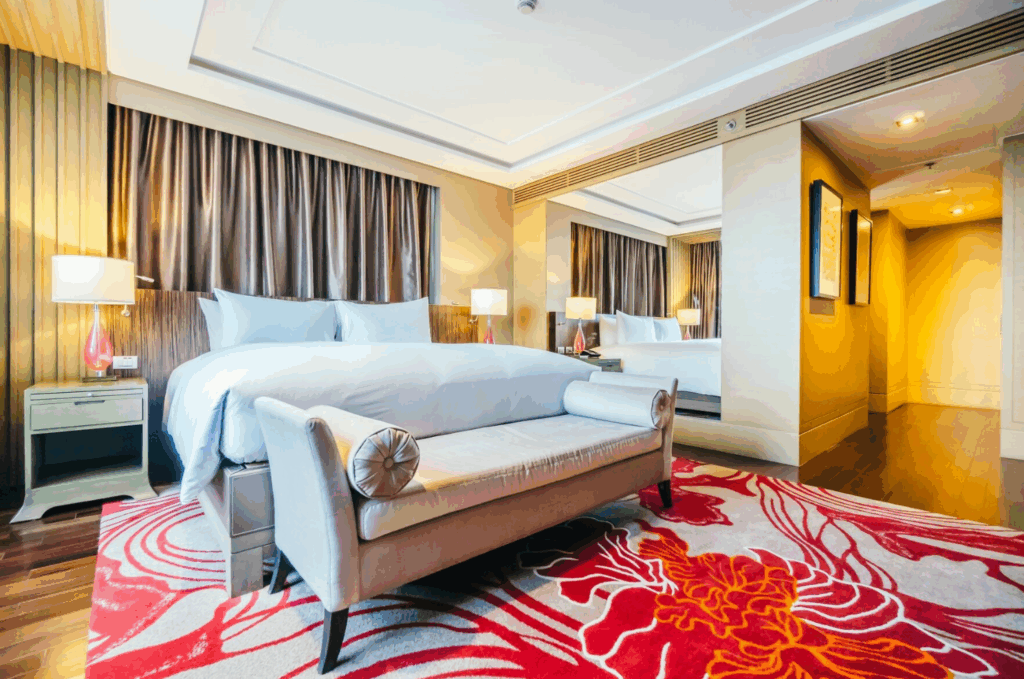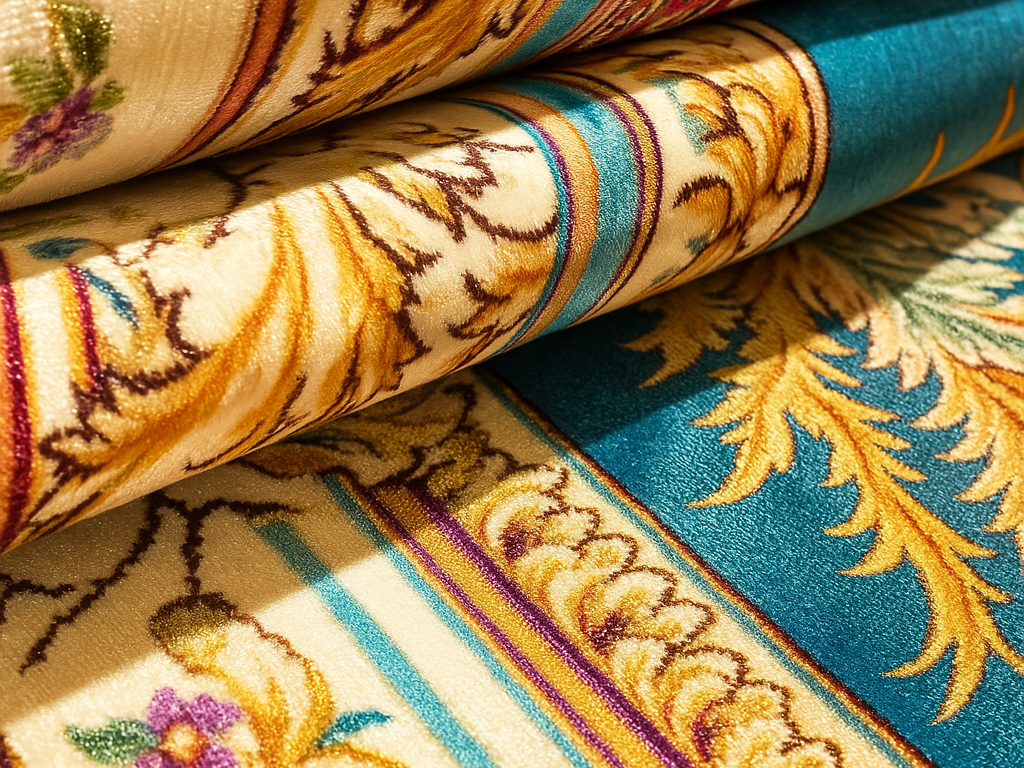カーペットの調子が悪くなったとき、あるいは単にスタイルを一新したいとき、カーペットの上にラグを敷くと、大胆かつ独創的に感じられます。摩耗や汚れを隠すだけでなく、空間に質感や個性、機能性をもたらします。カーペットの上にうまくラグを敷くと、ゾーンがはっきりし、足元の感触が柔らかくなり、美観が瞬時に向上するため、部屋が一変します。.

見た目だけでなく、実用的なメリットもあります。ラグはクッション性と保温性を高め、騒音をカットし、特に人の出入りが多い場所では既存のカーペットの寿命を延ばすこともできます。一番の利点は?ラグを替えるのは、壁一面のカーペットを取り替えるよりずっと簡単で、予算も抑えられます。.
なぜカーペットの上にラグを重ねるのが効果的なのか、何を考慮すべきか、どのようにスタイリングすべきか、どのような落とし穴を避けるべきか、安全でスタイリッシュに保つにはどうすればよいか、このガイドをお読みください。.
1.カーペットの上にラグを敷く理由
カーペットにシミがあったり、色あせがあったり、魅力がなくなっているかもしれません。カーペットの上に選りすぐりのラグを敷くだけで、機能性とセンスの両方を兼ね備えた、爽やかでシンプルなカーペットに生まれ変わります。.

即座のビジュアル刷新
ラグを敷くと、カーペット敷きの空間に大胆な色彩と豊かな質感、そして個性が加わります。オープンなフロアレイアウトの中で、読書スペースや会話スペースなど、ゾーンを視覚的に定義する力があります。あるRedditorがシェアしています:
“「エリアラグはカーペットの上で大活躍します。色と面白みを加え、リビングエリアを視覚的にはっきりさせるのに役立ちます”
ラグを重ねることで、「深み、質感、視覚的な面白さ」が加わり、居心地のよい、意図的な美学を作り上げることができる。.
擦り切れたカーペットや不要なカーペットのカバー
傷やシミを隠したい、あるいは家に付いてきたカーペットが見劣りする?ラグを敷けば、取り壊す必要もなく、負担の少ないコスメティック・アップデートができます。Houzzのホームオーナーも注目しています:
“カーペットの残念なシミを隠すために......引き裂くために......”
フラストレーションをスタイルに変える、精通したソリューションだ。.
居心地が良く、快適で、音を和らげる
ラグを重ねることで、見た目が良くなるだけでなく、生活も豊かになります。厚手のラグはクッション性があり、足音を和らげ、特に寒い季節には暖かさを保ちます。また、ラグは空間の触感も高めてくれます:
“「カーペットの上にラグを重ねることで、床にパッドが追加され、より快適で心地よくなる。”
低予算でありながら変革をもたらす
スタイルにはこだわるけれど、コストには気を遣うという方には、ラグの重ね張りがおすすめです。壁一面のカーペットを取り替えるとなると、費用がかさみ、厄介なことになりかねません。.
人通りの多い場所での実用的な保護
人の出入りが多い場所(玄関、廊下、遊び場など)は、非常に傷みやすい場所です。カーペットの上にラグを敷くと、汚れがたまりやすい場所にゴミがたまりにくくなり、カーペットの下は磨耗を防げます。.
ペットにもメリットがあり、カーペットにもメリットがあります:
“ペットが喜ぶ...掃除が楽になる...カーペット全体を掃除する代わりに、ラグを直接持ってこられる...”
実践的な表現とスタイル・プレー
ラグ、特に平織りや柄物は、シーズンごとにテクスチャーやスタイルを試す簡単な方法です。デザイン遊びのピースのような役割を果たし、永続的なこだわりを持たずに部屋に新鮮さを与えてくれます。.
2. カーペットの上にラグを敷くことの長所と短所

何がうまくいき、何がうまくいかないのか。.
カーペットにラグを敷く利点
- 視覚的アピールを高め、ゾーンを明確にする カーペットの上にラグを重ねることで、質感や色、視覚的なレイヤーが生まれ、部屋が意図的にコーディネートされているように感じられます。オープンプランのレイアウトでは、読書コーナーやシーティングエリアのようなスペースを固定するのに役立ちます。デザイナーはよく、ニュートラルなカーペットの上に柄物のラグを組み合わせて、印象的でありながらバランスの取れた外観に仕上げています。.
- クッション性と居心地の良さをプラス カーペットの上に豪華なラグを敷くと、足元に厚みが増し、周囲の騒音を消してくれるので、寒い季節には快適です。また、簡単に暖かさをプラスすることもできます。.
- 予算内で欠点を隠し、個性を出す 戦略的にラグを敷けば、擦り切れやシミ、あまり気に入っていないカーペットを隠すことができ、賃貸や古い家では特に魅力的です。特に賃貸住宅や古い住宅には魅力的です。.
- 人通りの多い場所を保護 廊下やプレイゾーンなど、摩耗や損傷が最も激しい場所にラグを使用することで、下地のカーペットを汚れや損傷から守り、カーペットの寿命を延ばします。.
- 設計の柔軟性を提供 カーペットを全面的に張り替えることなく、季節ごとやインスピレーションが湧いたときにラグを取り替えることができます。こだわりのないスタイリングです。.
カーペットの上にラグを敷くことの欠点
- スリップやつまずきのリスクの増加 適切な固定がないと、ラグは束になったり、気泡が入ったり、ずれたりして、つまずく危険性があります。.
“私は 違う カーペットよりも薄いラグをお勧めします。カーペットを敷いていたのですが、常にずれてダマになってしまって......今でも少しシワになっています」。”
- クリーニングはより複雑 ラグとカーペットの間には、ゴミやホコリ、パンくずが挟まることがあります。これでは掃除が面倒になるだけでなく、アレルゲンが足元に蓄積する危険性もあります。.
- 潜在的な損傷や変色 ラグはカーペットに染料をこすりつけたり(「クロッキング」と呼ばれる問題)、日光を遮って色あせムラを引き起こしたりします。また、時間が経つと、ラグの圧力でカーペットの下の繊維が平らになることもあります。.
- スタイル・ミス・ステップ ラグとカーペットの色や柄がぶつかったり、重ね方が不規則に感じられたりすると、空間が乱雑に見えたり、視覚的に混乱したりします。デザイナーは、重ねすぎやスタイルの不一致に注意を促しています。.
- 隠れたライフスタイルと健康の欠点 ラグの裏地(ゴムなど)の下に湿気がこもることで、カビが生えやすくなります。ホコリの蓄積と相まって、空気の質に影響を与える可能性があります。これを実際に経験したユーザーもいます。.
3. カーペットの上でラグを使用する際の注意点
カーペットの上にラグを敷くには、単にきれいな柄を選ぶだけでなく、質感、安定性、サイズ、素材、安全性を考慮する必要があります。Valhakの読者が賢く、スタイリッシュで、安全な選択ができるように、それを分解してみましょう。.

質感とカーペットの適合性
- カーペットのパイルにラグのプロファイルを合わせます。. カーペットがふかふかの場合、上に厚手のシャギーラグを敷いても、ふかふかの固まりに溶け込んでしまうだけです。代わりに 平織りまたは薄型ラグ でメリハリをつけ、ズレを抑える。デザインのプロは、「皮革、キリム、ドゥルリーなどはいずれも薄型のため、カーペットの上に敷いても見栄えがする」と強調し、ふかふかのカーペットと組み合わせた場合、トップラグが厚くなりすぎないよう注意を促している。.
- ロングパイル・カーペットを重ねないほうがいい場合もあります。. 非常に長くてシャギーなカーペットは、ラグの下の構造がまったくなく、良いパッドを敷いても座屈や滑りを防ぐことはできません。シワになりやすい構造なのです。.
ラグのサイズと配置
- スケールがすべてだ。. 小さすぎるラグは不格好に見え、家具が浮いて見える。デザイナーは 6~24インチ カーペットの縁取り。.
- アンカーは賢く。. ラグの位置 主要な家具はすべて、少なくとも前脚はその上に置く。. そうすることで、平らで接地した状態を保つことができる。.
動きと滑りの防止
- 適切なラグパッドを使用してください。. を選ぶ カーペット用滑り止めパッド-平織りのラグには滑りにくい薄手のパッドを、重量のあるラグには厚手のフェルト/ゴムパッドを。.
- 絨毯を戦略的に固定する。. 重い 家具 ラグがずれないようにするのに役立ちます。両面シリコーン・ラグテープも選択肢のひとつで、特にアンカーピースのない場所では有効です。.
- ユーザーからの真の洞察:
- “私は 違う カーペットの上に薄いラグを敷くことをお勧めします。カーペットの上に薄手のラグを敷いているのですが、常にずれたり、シワになったりするんです。「カーペットの上にラグを敷いています。カーペットの上にラグを敷いているのですが、その下にカビが生えてしまいました。これらは、安全面でも衛生面でも、カーペットの質感と裏地をお客様の状況に合わせることがいかに重要であるかを物語っています。.
素材とラグの裏地に関する考察
- カビが生えたり変色したりしやすい裏地は避ける。. ゴムや合成繊維の裏は湿気がこもったり、染料が移ったりする可能性があり、カーペットを傷めたり、カビの発生を促したりする可能性があります。あるRedditorはこう話している:
“どんな絨毯でも安全なはずだが......こぼれたようだ......絨毯の底はゴム状になっている......”
- 最善の策だ: のラグを選ぶ。 天然繊維または綿/ポリエステル混紡の裏地, とペアを組む。 フェルト/ラバー・リバーシブル・パッド バランスと安全のために。.
清掃と維持管理の現実
- 定期的に掃除機をかける。. 繊維を鈍らせたり、臭いの原因となる蓄積を防ぐため、週に一度はラグを持ち上げ、パッドの下に掃除機をかけます。.
- 湿気に注意し、通気性を保つ。. 重い絨毯は下に湿気がこもりやすくなります。湿気の多い環境では、カーペットとラグのパッドの間に防湿壁を追加することを検討してください。あるユーザーはこう説明する:
“「水蒸気バリアーを作るためにラグパッドを敷きたいだろう......」。”
安全性、試用、調整
- 可能であれば最初にテストを行う。. 可能であれば、カーペットとラグの裏の見本を1~2日置いて、変色や滑りを早期に発見してください。.
- 安全を優先する。. どんなに美しいデザインでも、それが危険であれば意味がありません。特に人通りの多い場所では、波打ったり、束になったり、角が丸まったりしていないかを常に見極めましょう。.
4. カーペットにラグを正しく敷くには?
カーペットの上にラグを重ねるのは、インテリアと同じくらい難しい作業です。素材から配置に至るまで、細部まで精巧に仕上げるためのプロセスをご紹介しましょう。.

正しいベース作りから始めよう
- 豪華なカーペットには薄手のラグを選ぶ, その逆もあります。厚みのある豪華なカーペットには、薄手で平織りのラグがコントラストと安定性に優れ、短いカーペットやループ状のカーペットには、落ち着きと柔らかさを求めてシャギーにする余裕があります。.
- テクスチャーのコントラストに注意. .ハイパイルカーペットの上に滑らかな平織りを施せば、見た目にも美しく、機能的にも優れている。.
スケールと配置を正しくする
- バランスが鍵. .家具がラグを固定するようにします。ソファやコーヒーテーブルの両前脚がラグの上に乗るようにするのが理想的です。カーペットの境界線は6~24インチ残してください。 壁一面のカーペット-視覚的な混雑を避けるため.
- 意図して重ねる. .まず大きめのニュートラルなラグを下に敷き、その上に小さめの鮮やかなラグや質感のあるラグを重ねます。さらに、コーヒーテーブルや読書コーナーなど、特定のゾーンに注目させることもできます。.
- 配置ジオメトリで遊ぶ. .ベースとなるラグは、部屋のラインに合わせて直線的に敷き、トップとなるラグには角度をつけて(斜め45度など)、さりげなく視線を集めたり、奇抜さを加えたりします。スタジオのデザイナーは、このアシンメトリーなレイヤリングを「デザイナーの遊び心の秘密」と呼んでいます。 .
固定する-さまよわせない
- カーペット対カーペットの滑り止めパッドを使用する。. .このスリムで粘着性のあるパッドは、感触や高さを変えることなくグリップ力を発揮します。豪華なラグにはフェルトとゴムのリバーシブルパッドが適していますが、平織りのラグには滑らかで薄い滑り止めが適しています。.
- 必要に応じてアンカーを追加する. .人通りの多い場所では、パッドを重い家具と組み合わせます。その他の場所では、ラグテープや専用の両面グリップを使います。Kppexの雲形ステッカーのような両面グリップは、目立たず効果的で、使用者はラグが「1インチも動かない」と言います。.
- DIYアンカー・ハック. .Redditorsは機知に富んでおり、ある人はカーペットとラグの両方の小さな穴にジップタイを差し込んだり、別の人はラグの角に隠しネジで固定したりしている。ありきたりではないが、クリエイティブで機能的だ。.
安全でスマートなバッキングを選ぶ
- 湿気のこもりやすいラバーバックは避ける 通気性がなければ、カビの温床となる。その代わり、通気性のある裏地を選ぶか、しっかりグリップするためのパッドに頼ること。.
- 染色転写のテスト. .カーペットの上に小さなラグサンプルを1~2日置き、変色や染料が移っていないか確認してから、ラグ全体を敷いてください。.
新鮮さを保つ-意図を持って維持する
- 定期的に下を持ち上げて掃除機をかける. .見た目にはきれいでも、絨毯の下にはホコリや繊維が溜まっていることがあります。カーペットの健康を維持するために、レイヤーの下は毎週掃除機をかけるようにしてください。.
- エッジに注意. .つまずかないように、丸まった角を少し重りをつけて平らにするか、テープやグリップで固定する。.
5. 質感のマッチング:カーペットの上に敷くのに最適なラグは?
カーペットに合ったラグを選ぶことは、単なるデザイン上の工夫ではありません。調和と安全性、そして快適性です:

ショートパイルまたはループカーペット(ベルベルなど)
このようなしっかりした構造のカーペットは優れた土台となります。シャギーやディープパイルのようなふっくらとした厚みのあるラグを重ねると、コントラストが際立ち、足元が心地よくなります。アバロン・フローリングによると
“「エリアラグは一般的に、毛足の短いカーペットやループカーペットの上に敷くのが最適です。...厚手で高級感のあるシャギーラグを敷くと、空間に柔らかさとエレガントさが加わります。”
DesignerTrappedもこれに賛同し、質感の衝突を避けるため、薄手のカーペットの上に豪華なラグを敷くことを勧めている。.
プラッシュまたはハイパイルカーペット(サキソニー、カットパイルなど)
ふっくらとした心地よさを提供しますが、ラグもふっくらとしたものだと、上のラグが不安定に感じられることがあります。コツはコントラストです。 薄型、平織り、ベルベル絨毯 視覚的に分離し、滑りを防止する:
“「厚みのあるカーペットを敷いている場合は、その上に厚みのあるエリアラグを敷くのは避けましょう。”
一般的なガイダンスでは、レイヤリングを成功させるために天然素材の薄型ラグを使用するよう注意喚起されている。.
ハイパイルまたはシャギー・カーペット
毛足の長いカーペットはトラクションが弱く、ラグの敷き方が不安定になります。DesignerTrappedとAvalon Flooringの両社は、このような表面にはラグを重ねないようアドバイスしています。.
素材と色のコントラストによるマッチング
- 質感のコントラストが勝つ。. フラットなジュートやドゥーリに柔らかいウールのアクセントラグを組み合わせると、興奮と触感が生まれます。シチズンリーは、素材や毛足の高さをミックスすることで、「さらにドラマチックになる」と指摘しています。“
- 色と柄のバランス。. カーペットがニュートラルな色(ベージュやグレー)なら、落ち着いたブルーやテラコッタ、深いグリーンのラグを選ぶと、ぶつかることなく個性を演出できます。家具にプリント柄を使う場合は柄を控えめにし、空間のフォーカルポイントになるようなものだけを大胆に使いましょう。.
美しく重なるラグの種類
カーペットの上でも)相性の良いラグのスタイルを簡単にご紹介します:
- 平織り/ドゥーリ - 薄型、軽量で、レイヤリングを楽しめる。.
- シャギーラグ - ソフトでラグジュアリーな風合いを出すために、毛足の少ない床の上に敷くのが最適。.
- ジュート/天然繊維ラグ - アースカラーで質感があり、コントラストやレイヤリングに最適(特にシープスキンなどのアクセントとなる質感とスタイリングした場合)。.
- 機械織り / 丈夫なラグ - 実用的で掃除がしやすく、カーペットの上に敷いて、人の出入りの多いゾーンに最適。.
6.メンテナンスを簡単に:カーペットに敷いたラグのクリーニングのコツ
掃除は少し増えるが、なんとかなる:
- 定期的に掃除機をかける:絨毯とその下のカーペットは注意が必要です。人の出入りが多い場所は頻繁に掃除する必要があります。.
- シミを速やかに処理する:決してこすらないでください。中性洗剤、または青ラベルのシミ抜き剤を使用する。過度の湿気は避ける。.
- DIYの奇跡:のペースト 重曹, 過酸化水素と食器用洗剤は、絨毯とカーペットのシミ抜きのトレンドだ。.
- ディープクリーニング:Bissell HydroSteamやShark Stainstrikerのようなスポット用スチームクリーナーを使えば、パワーと利便性を両立できる。.
- 予防習慣:靴を脱いでドアマットを使用し、絨毯の下は定期的に掃除機をかけて汚れを溜めないようにする。.
また、小さなラグは洗濯機で洗い、大きなラグは叩いたり振ったり、クリーニング方法のラベルに注意するなど、素材に合わせたお手入れをしてください。.
7.カーペットの上にラグを敷くとき、よくある間違いを避けよう
いくつかの不手際は伏せておく価値がある:
- ラグパッドの省略:スリップ、バンチングを引き起こし、両表面の摩耗が進む。.
- サイズと配置を無視:小さなラグは不格好に見え、固定されていないラグは危険だ。.
- パターンの重ねすぎ:競合するプリントが多すぎると、スペースが圧迫されます。.
- 下の掃除を怠る:汚れは目に見えないところに蓄積されるので、縁の下の掃除機は欠かせない。.
- 豪華でスタイリッシュなカーペットの上に、不必要にラグを敷く。:かさばり、美観を乱す。.
8.結論
要するに、カーペットの上にラグを敷くことは、思慮深く行えば、デザイン上の勝利につながるということです。カーペットは快適で、スタイルが良く、保護効果もあり、予算内で空間をリフレッシュするチャンスでもあります。しかし、万能ではありません。テクスチャーを合わせ、固定し、クリーニングし、意図的にスタイリングする。そうすれば、老朽化したカーペットも、ラグを敷くことで洗練された空間に生まれ変わります。.
9.よくあるご質問
1. カーペットの上にラグを敷くことはできますか?
カーペットの上にラグを敷くのは、スタイルと暖かさをプラスし、擦り切れた部分を隠す賢い方法です。.
2. ラグが滑らないようにするにはどうしたらいいですか?
カーペット対カーペットのラグパッド、ラグテープ、家具の下の固定用エッジなどを使って安全に固定します。.
3. どのような種類のラグがプラッシュ・カーペットに最適ですか?
平織りや薄型のラグを選びましょう。豪華なカーペットの上に厚手のラグを敷くと、やりすぎに見え、安定感がなくなります。.
4. ラグの下はどのくらいの頻度で掃除すべきですか?
カーペットの下に定期的に掃除機をかけ、少なくともカーペットと同じ頻度で掃除機をかけます。.
5. シミに家庭療法は使えますか?
もちろん。重曹、過酸化水素、食器用洗剤の自家製ペーストは効果的で、お財布にも優しい。.


